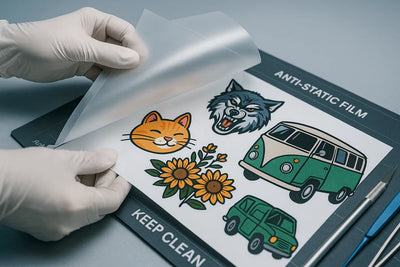

DTF Printing Troubleshooting Guide: Fix These 12 Common Problems Fast
Jul 3, 2025 (Updated on Sep 26, 2025)
DTF printing problems can derail your business momentum and frustrate customers. Whether you're running your own equipment or experiencing issues with outsourced work, understanding common DTF problems and their solutions is crucial for maintaining quality and profitability. This comprehensive troubleshooting guide will help you identify, diagnose, and resolve the most frequent DTF printing challenges.
Why DTF Troubleshooting Matters for Your Business
Professional DTF printing requires precision at every step. Even minor issues can result in:
- Customer complaints and refunds
- Wasted materials and time
- Damage to your business reputation
- Lost revenue from rejected orders
Understanding these problems helps you make informed decisions about when to handle projects in-house versus partnering with professional services for guaranteed results.
The 12 Most Common DTF Printing Problems
1. Poor Adhesion and Peeling
Symptoms: Transfers don’t stick properly, edges lift after washing, or design peels off entirely.
Causes:
- Incorrect heat press temperature (should be 280-300°F)
- Insufficient pressure during application
- Wrong pressing time (typically 9-13 seconds)
- Contaminated or pre-treated fabrics
- Moisture in the fabric or environment
Solutions:
- Verify heat press calibration with infrared thermometer
- Increase pressure to medium-firm (6 KG)
- Pre-press garments to remove moisture
- Test on fabric samples before full production
- Professional Alternative: Use proven gang sheet services with guaranteed adhesion
2. White Ink Sedimentation and Clogging
Symptoms: White ink appears streaky, missing, or uneven. Printheads may clog frequently.
Causes:
- White ink settling due to lack of circulation
- Improper storage of ink cartridges
- Infrequent printer use allowing ink to separate
- Low-quality white ink formulations
Solutions:
- Implement white ink circulation system
- Shake cartridges gently before each use
- Run cleaning cycles every 48–72 hours
- Invest in high-quality ink with better suspension properties
- Professional Alternative: Eliminate ink management headaches with professional DTF services
3. Color Bleeding and Migration
Symptoms: Colors bleed into each other, creating muddy or unclear designs.
Causes:
- Excessive ink saturation
- Incorrect ink profiles or color settings
- Poor quality DTF film absorption
- Contaminated adhesive powder
Solutions:
- Reduce ink density in printer settings (80–90% recommended)
- Use proper ICC color profiles for your printer
- Source premium DTF films with better ink absorption
- Store adhesive powder in controlled, dry environment
- Quality Assurance: Professional gang sheet services use calibrated color systems
4. Cracking After Washing
Symptoms: Designs develop cracks, lines, or splits after laundering.
Causes:
- Over-curing during initial application
- Inadequate pre-washing instructions to customers
- Poor quality DTF films
- Incorrect wash temperature recommendations
Solutions:
- Follow manufacturer’s exact curing specifications
- Provide detailed washing instructions (inside-out, cold water)
- Test wash durability before customer delivery
- Use premium DTF materials rated for 50+ washes
- Reliability Guarantee: Professional services offer 50+ wash guarantees
5. Inconsistent Print Quality
Symptoms: Some prints are vibrant while others appear faded or have missing elements.
Causes:
- Printhead alignment issues
- Inconsistent ink flow or pressure
- Environmental factors (humidity, temperature)
- Worn or damaged printheads
Solutions:
- Perform regular printhead alignment and cleaning
- Monitor environmental conditions (40–60% humidity ideal)
- Replace worn printheads according to manufacturer schedule
- Maintain consistent room temperature (68–75°F)
- Consistent Quality: Professional operations maintain controlled environments
6. Powder Application Problems
Symptoms: Uneven powder coverage, excess powder buildup, or poor adhesion.
Causes:
- Incorrect powder application technique
- Wrong powder particle size
- Timing issues between printing and powdering
- Contaminated or old adhesive powder
Solutions:
- Apply powder within 30 seconds of printing
- Use appropriate mesh size for even distribution
- Store powder in airtight containers with desiccant
- Replace powder every 6 months regardless of appearance
- Professional Equipment: Gang sheet services use automated powder systems
7. Film Stretching and Distortion
Symptoms: Designs appear stretched, warped, or disproportionate.
Causes:
- Film tension issues during printing
- Incorrect heat settings causing film shrinkage
- Poor quality DTF films
- Mechanical printer problems
Solutions:
- Adjust film tension settings on printer
- Use manufacturer-recommended heat settings
- Source DTF films from reputable suppliers only
- Regular printer maintenance and calibration
- Precision Control: Professional services eliminate distortion risks
8. Static Electricity Issues
Symptoms: Film sticks to printer components, powder distribution problems, dust attraction.
Causes:
- Low humidity environments
- Synthetic materials generating static
- Lack of anti-static equipment
- Improper grounding
Solutions:
- Maintain 45–55% relative humidity
- Install anti-static bars or ionizers
- Use anti-static sprays on work surfaces
- Ensure proper electrical grounding
- Controlled Environment: Professional facilities manage static control
9. Color Accuracy Problems
Symptoms: Printed colors don’t match screen displays or customer expectations.
Causes:
- Uncalibrated monitors
- Incorrect color profiles
- Poor quality ink or film interactions
- Lighting conditions affecting perception
Solutions:
- Calibrate monitors monthly with colorimeter
- Use industry-standard color profiles (Adobe RGB, sRGB)
- Create custom ICC profiles for your equipment
- Standardize viewing conditions with D65 lighting
- Color Consistency: Professional services use calibrated color management
10. Heat Press Marks and Scorching
Symptoms: Shiny marks, discoloration, or burnt areas on fabric around transfers.
Causes:
- Excessive heat or pressure
- Uneven heat distribution
- Dirty or damaged heat press plates
- Wrong pressing materials or techniques
Solutions:
- Reduce temperature by 10–20°F and test
- Clean heat press plates regularly
- Use Teflon sheets or parchment paper barriers
- Check heat press calibration monthly
- Professional Equipment: Industrial heat presses prevent scorching
11. Edge Definition Problems
Symptoms: Blurry edges, feathering, or soft definition on design elements.
Causes:
- Incorrect print resolution settings
- Poor file preparation (low DPI)
- Ink bleeding due to over-saturation
- Film quality issues
Solutions:
- Use minimum 300 DPI source files
- Optimize print resolution settings (720 DPI minimum)
- Adjust ink limits in RIP software
- Test different DTF film brands for sharpness
- Sharp Results: Professional printing uses optimized settings
12. Production Speed Bottlenecks
Symptoms: Slow printing speeds, frequent pauses, or equipment downtime.
Causes:
- Inadequate printer maintenance
- Suboptimal print settings
- Poor workflow organization
- Equipment capacity limitations
Solutions:
- Implement preventive maintenance schedules
- Optimize print modes for speed vs. quality balance
- Organize production workflow efficiently
- Consider equipment upgrades for volume needs
- High-Speed Production: Gang sheet services offer 80,000+ inches daily capacity
When to Outsource vs. Fix In-House
Outsource When:
- Equipment limitations prevent quality results
- Time constraints require guaranteed delivery
- Volume exceeds your capacity
- Customer requires specific quality standards
- Learning curve impacts profitability
Professional services like DTF Dallas gang sheets and custom transfers eliminate troubleshooting headaches while ensuring consistent, high-quality results.
Fix In-House When:
- Problems are clearly identified and solvable
- You have time for experimentation
- Equipment is relatively new and reliable
-
Volume is low and manageable
Prevention Strategies
Daily Maintenance Checklist
- Check ink levels and circulation
- Clean printhead nozzles
- Verify heat press calibration
- Monitor environmental conditions
- Organize workspace for efficiency
Weekly Maintenance
- Deep clean printheads
- Calibrate color profiles
- Check film and powder inventory
- Review quality control samples
- Update equipment firmware
Monthly Reviews
- Analyze quality metrics
- Review customer feedback
- Assess equipment performance
- Plan preventive maintenance
- Evaluate outsourcing vs. in-house costs
Building Quality Control Systems
Sample Testing Protocol
- Print test patterns daily
- Check adhesion on various fabrics
- Monitor color consistency
- Test wash durability weekly
- Document all issues and solutions
Customer Quality Assurance
- Provide detailed care instructions
- Offer quality guarantees
- Respond quickly to issues
- Maintain detailed quality records
- Partner with reliable suppliers
Cost-Benefit Analysis: In-House vs. Professional Services
In-House Troubleshooting Costs
- Equipment maintenance: $200–$500/month
- Material waste: $150–$400/month
- Time investment: 10–20 hours/month
- Quality inconsistencies: Customer complaints and refunds
Professional Service Benefits
- Guaranteed quality: No troubleshooting needed
- Predictable costs: Fixed pricing per piece
- Time savings: Focus on sales and customer service
- Scalability: Handle any volume without equipment limits
Gang sheet services and custom transfer options often prove more cost-effective than maintaining in-house troubleshooting capabilities.
Emergency Troubleshooting Quick Reference
Immediate Actions for Common Issues:
- No Adhesion: Increase heat by 10°F, extend time by 2 seconds
- Color Bleeding: Reduce ink density to 85%, check film quality
- White Ink Issues: Run cleaning cycle, check ink circulation
- Cracking: Reduce heat by 15°F, check fabric compatibility
- Poor Edges: Increase resolution, check file quality
- Powder Problems: Check application timing, replace old powder
Technology Integration for Better Results
Modern Solutions
- Automated powder application systems
- RIP software with advanced color management
- Environmental monitoring systems
- Predictive maintenance alerts
- Quality control cameras and sensors
Future-Proofing Your Operation
Consider whether investing in advanced troubleshooting equipment makes sense versus partnering with facilities that already have these capabilities through professional DTF services.
Conclusion: Smart Problem-Solving for DTF Success
Successful DTF printing requires mastering both technical skills and business strategy. While understanding troubleshooting is valuable, smart entrepreneurs recognize when professional services offer better ROI than in-house problem-solving.
The key is finding the right balance: handle simple issues in-house while leveraging professional gang sheet services and custom transfer options for complex projects requiring guaranteed results.
By implementing the troubleshooting strategies in this guide and knowing when to outsource, you’ll minimize downtime, reduce costs, and ensure consistent quality that builds customer loyalty and drives business growth.
Tired of DTF troubleshooting headaches? Explore our professional gang sheet services and custom transfer solutions for guaranteed quality without the hassle. Focus on growing your business while we handle the technical challenges.
Contact DTF Dallas for expert consultation on optimizing your DTF workflow and eliminating common production problems.
Comments 0
Be the first to leave a comment.




